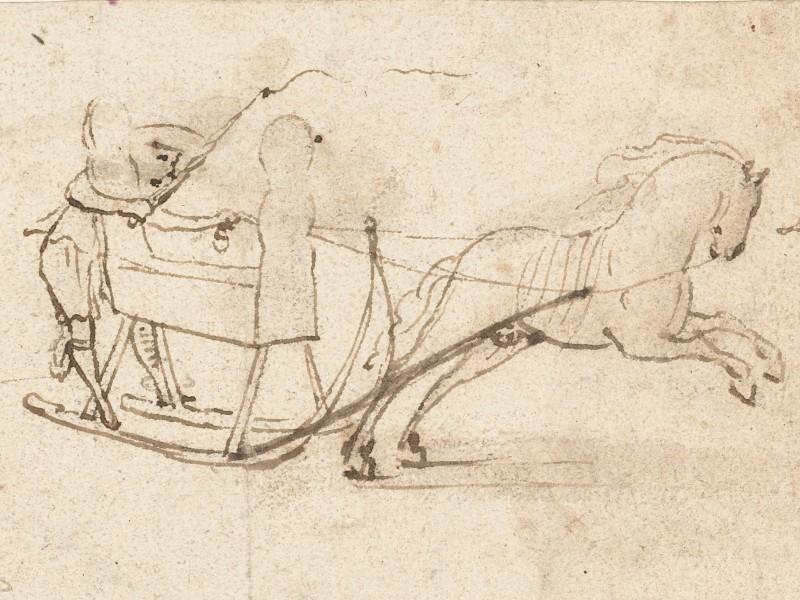
“I had a young, lively horse pulling my sledge. When we went downhill, the sledge struck the back leg of the horse. The startled animal began galloping at full speed down the slope. I was afraid for my life but could not disembark from the sledge.“1
From Jönköping to Stockholm
13 February – 23 February 1586
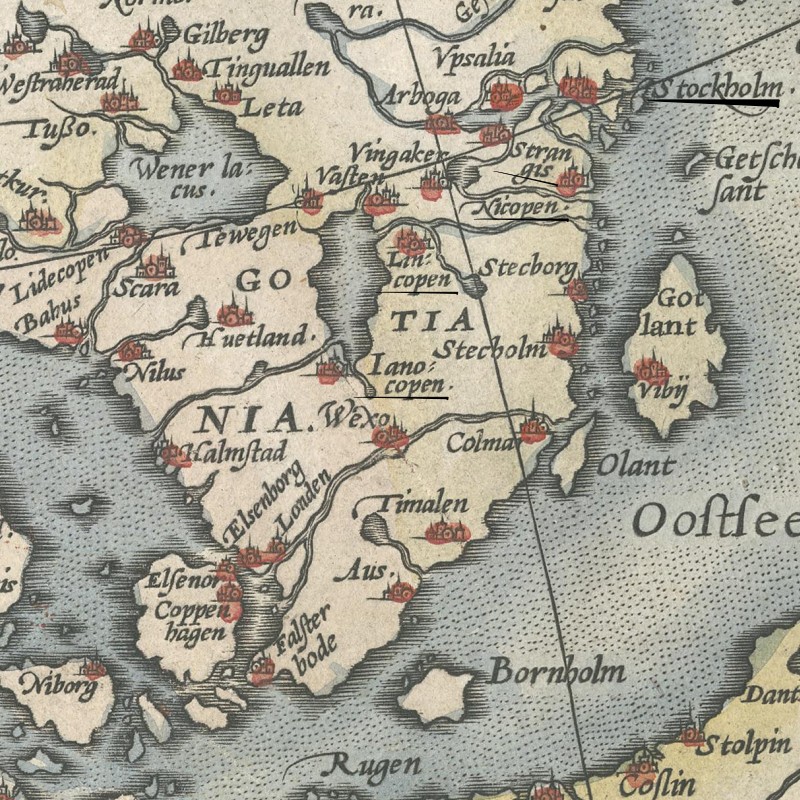
Sweden around 1570, with Samuel Kiechel’s main stops
Sunday in Jönköping
Samuel Kiechel and his two companions spent a night in Jönköping. The next day was a Sunday, and it was the festive time of Carnival (Shrovetide), which was widely celebrated in Sweden. Kiechel observed that during this period, people prepared large quantities of food, including brawn, ham, pigs’ heads, tongue, smoked meat, bacon and other items. All this food had a long storage life and would still be served a month or six weeks later, just as the travellers had been served meat on their journey that had been cooked at Christmas.
The three travellers had found accommodation in the mayor’s house, where they were also invited to lunch. Kiechel had already mentioned that they travelled with a stock of beverages in nine glass bottles. He explained that in many parts of Sweden, there was no wine or beer available, only murky water. They shared some of their drinks with their host, which was presumably much appreciated.
After lunch, the travellers left Jönköping. Kiechel noted that the town was situated in a valley, and as they departed, the road led them back into the mountains. They had hired a sledge to carry them for two miles. To the left of the road was a vast lake, one mile wide and eighteen miles long (Lake Vättern).
A Terrible Loss
After two miles, they sent the horses back to Jönköping and hired new animals. Kiechel wrote that the new horse harnessed to his sledge was small, brave and fresh. The travellers continued their journey, but soon Kiechel fell behind his companions. Suddenly, his horse began to speed up and chase after the other sledge. Our traveller was unable to stop the animal; the sledge hit a stone, tipped over, and he fell out. However, the horse did not stop. It continued its run, dragging the sledge behind it.
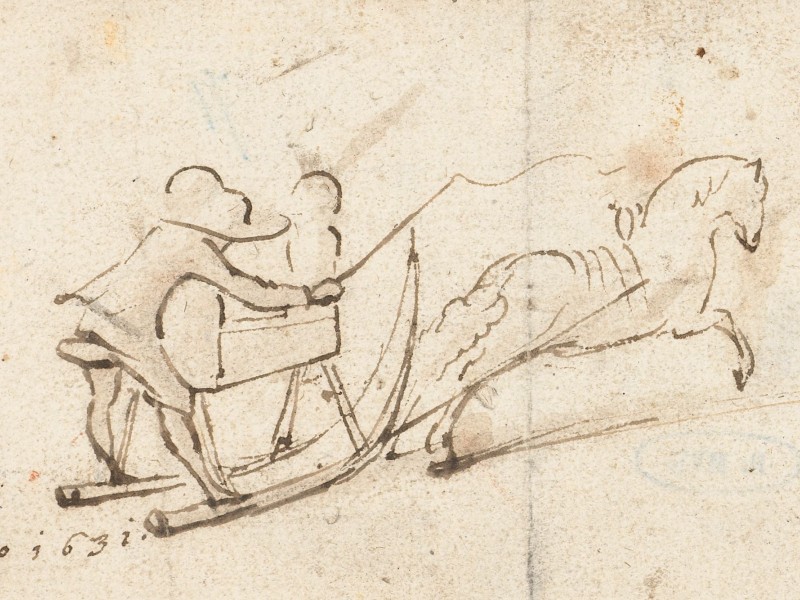
The crash had serious consequences. The group’s supply of beverages was in the sledge. Kiechel had secured it with some rope, but it had fallen out of the sledge and was now being dragged behind it. Eventually, the rope snapped, and the store’s lock opened; three full bottles fell out and broke. Upon reaching the other sledge, Kiechel’s horse finally slowed and stopped. However, the loss of the bottles weighed heavily on the travellers.
In the evening, the group stopped in the hamlet of Gränna and resumed their journey the following day (14 February). They travelled along Lake Vättern and arrived at lunchtime at the house of a wealthy parish priest. The priest already had other guests, but the travellers were invited to join them. Food and drink were served, and the group was treated very well before continuing their journey.
More Difficulties and Accidents
In the late afternoon, Kiechel and his companions again lost their way and came to a small river. It was too deep to cross with their sledges, and they could not see a bridge. They followed the river and, eventually, heard dogs barking on the other side. The travellers presumed there was a house or village nearby. They spent more time searching for a bridge and found one long after nightfall. Not far from the bridge was a small hamlet where they spent the night in the house of a peasant. According to Kiechel, the hamlet was called Onsdau.
Wasting so much time, firstly getting lost and then finding a bridge to cross the river, led Samuel Kiechel to sum up his experiences of travelling in Scandinavia so far. He wrote: It is difficult for a foreigner who does not know the roads and does not speak the local language. The peasants (hosts?) rarely accompany the horses they rent out, nor do they send a servant along. Often, only a small boy is sent to lead the animals back. Those boys were poorly dressed, and Kiechel was surprised that they did not suffer any frostbite from the cold.
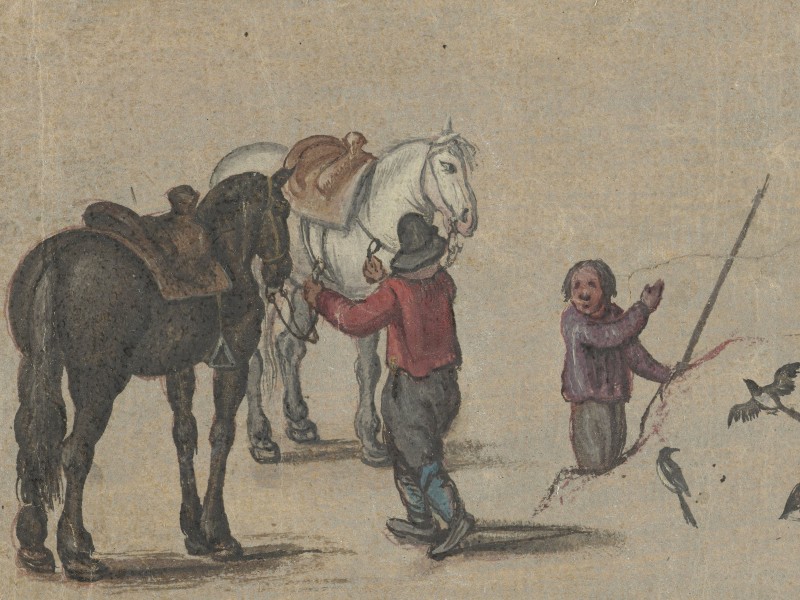
The travellers continued their journey the following morning. Samuel Kiechel now had a quick and lively horse drawing his sledge. When they descended a hill on a sunken lane, the sledge ran into one of the horse’s hind legs. Startled, the animal bolted and galloped at full speed down the hill. In the sledge, Kiechel was scared but did not dare jump off due to the high speed. Fortunately, at the bottom of the hill was a frozen lake where our traveller could let the horse run until it decided to slow down.
A quarter of a mile further along the road, the same thing happened again. But this time, there was no spacious frozen lake, and the road led towards a bridge. Kiechel decided it was safer to jump off as he was afraid that he might otherwise be dragged into the water below the bridge. The horse continued, and the sledge hit various obstacles. It was eventually too damaged to be of use. But fortunately, Kiechel wrote, the group’s store of drinks was not on his sledge this time. It would have been destroyed, and they would have lost all their wine.
After a further hour of travelling, the three men arrived in Linköping. They did not stay but continued on their way and stopped in the evening in Söderköping. Both towns are in the province of Östergötland.
Söderköping and Norrköping
Kiechel wrote: Söderköping is on an arm of the Baltic Sea that reaches into the town. Despite the cold, rocky, desolate and mountainous landscape, the people grow more food than they need. Large amounts of produce are therefore exported every year to Lübeck. The exported grain is of better quality than the Polish or Lithuanian grain and is sold for a higher price.
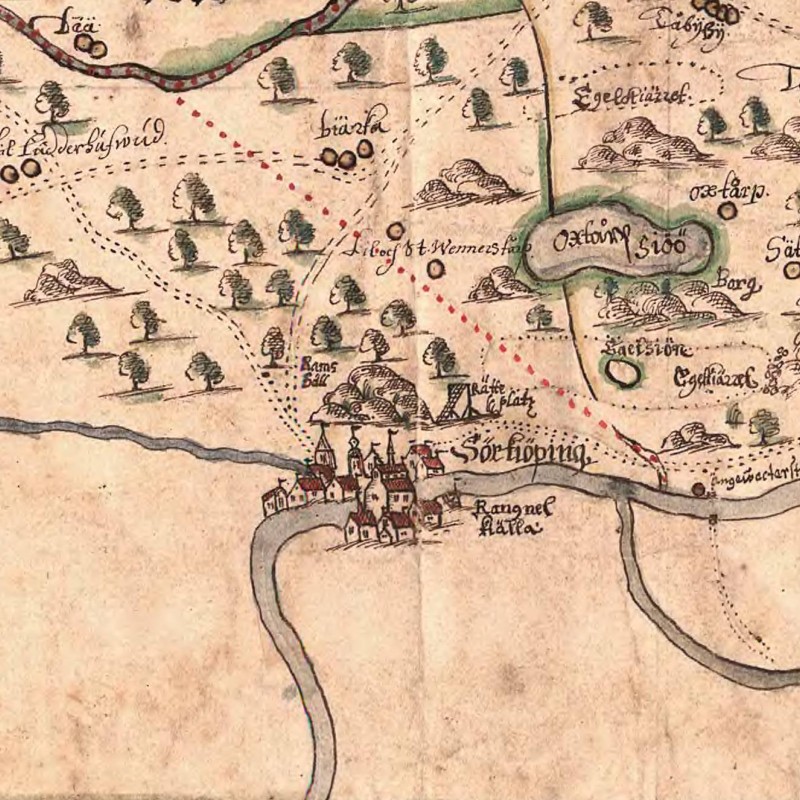
Söderköping
Samuel Kiechel stayed in Söderköping for a day because his companions had business to conduct in the town. In the afternoon of 17 February, the three men left and travelled the short distance to Norrköping, where they stayed with an acquaintance of Kiechel’s companions.
According to Kiechel, Norrköping is on the bank of a large freshwater lake (Lake Glan). The lake is twenty-eight Swedish miles long and two to three miles wide. The exit of the lake is right by the city, and the water falls from a high elevation. Many mills were built there and are powered by the falling water. Kiechel added that the water flowed through rocks and around rocky outcrops, forming a large river that eventually flowed into the Baltic Sea.
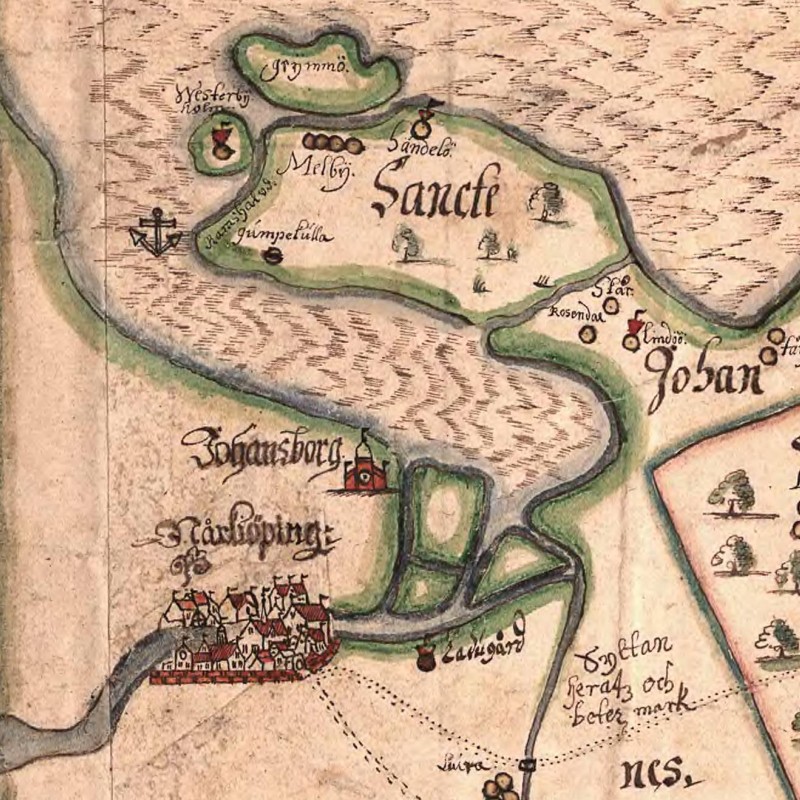
Norrköping
The river Kiechel described is the Motala Ström. In Norrköping, the river drops twenty-two meters through various waterfalls and rapids.
Samuel Kiechel further reported that salmon are caught in Norrköping. He learnt that the salmon swim upstream and against the current of the river from the Baltic Sea to the waterfalls. At the waterfalls, the fish are caught in large numbers. Every year, many hundredweights are exported.
After one night in Norrköping, the travellers left the following morning (18 February). However, half a mile outside the town, one of the two men they had hired as guides began to complain and obstruct their journey. He had only been hired because he owned a sledge and a horse. Kiechel and his companions decided to stop at a farmstead to get a new horse and thereby rid themselves of this obstinate man. However, the travellers were not only unable to rent a horse; now, their second guide had joined the first, and both men refused to travel any further. In addition, the peasants at this farm sided with the two guides. The argument nearly led to a fight. Eventually, Kiechel and his companions had no choice but to return to Norrköping to hire new horses and sledges. While the guides were unwilling to continue, they guided the group back to the town. But due to the trouble, the travellers refused to pay them. All these difficulties meant that the group only travelled three miles to a village called Birlingstau before nightfall.
Nyköping
The following day, Samuel Kiechel and his companions continued their journey, arriving in Nyköping at midday. Our traveller noted that their route crossed the frozen sea. This sea was the Bråviken, a bay of the Baltic Sea with the town of Norrköping at its end. As it was winter, the bay was frozen, making crossing the ice easier than travelling along rough, frozen roads.
On their way to Nyköping, the group passed a copper mine owned by Duke Charles (1550-1611, King of Sweden from 1604 to 1611). Charles was the brother of the current Swedish King, John III (1537-1592), and he had his court in Nyköping. The Duke was married to a daughter of the Elector Palatine from Heidelberg, (Maria of the Palatinate (1561-1589), daughter of Louis VI, Elector Palatine). Our traveller observed that the construction of the Duke’s castle in Nyköping was not yet finished. From the outside, it appeared rough and incomplete.
Nyköping was an unfortified town, and Kiechel remarked that none of Sweden’s cities were surrounded by walls. Moreover, the town was situated in an unappealing area, and our traveller mused that it did not attract many nobles or foreign dignitaries. An inlet from the Baltic Sea near the town allowed ships to reach Nyköping during the summer.
The travellers left the horses they had hired in the morning in Nyköping, and it took some time to find replacements. When they finally set off again, they missed the road amidst all the snow and travelled into the night until they found a farmstead. The owner was not particularly pleased to see the travellers because they had woken him up, but he permitted them to stay overnight. The farm was called Önnersta.
Regarding bedding in Sweden, Samuel Kiechel wrote: If a traveller wishes to sleep in a bed in this country, he would need to bring his own and stick the feathers from the bedding into his hat. Kiechel repeatedly mentioned that he had to sleep on the ground or a bench.
The following morning, the group continued their journey. Their route took them across frozen lakes until they reached Strängnäs, a small, unfortified town, by midday. Strängnäs was the seat of an archdiocese.
Duke Charles at the Fair
At the time of Kiechel’s visit, a fair was held in Strängnäs. His companions had business to attend to at the fair, so the travellers spent the next two days in the town. Kiechel had time to explore. He learned that merchants from Stockholm came to the fair, where many horses were bought and sold.
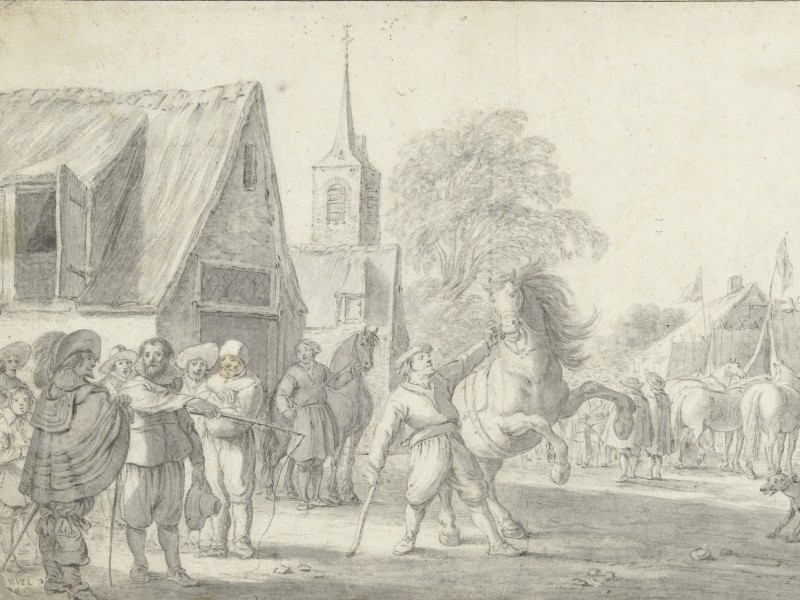
Kiechel noted that the horses are strong and sturdy animals. However, people rarely rode them because the roads were too poor in the summer. They were deep, swampy, waterlogged, and full of moss, as Kiechel would experience on his return journey. Eight or nine-year-old horses had never carried saddles and had only been used to pull sledges. Furthermore, Kiechel observed that Swedish horses are at their best when they are nine or ten years old. Up to the age of five, they are not used because their muscles are not yet strong enough.
Strängnäs belonged to Duke Charles’s domain, and Kiechel saw the Duke visit the fair. Our traveller wrote: The Duke walked among the stalls of the small traders and encouraged the people to be honest and fair in their dealings. While doing this, he was approached by an old peasant. Our traveller commented that people of a hundred years or more are frequently found in Sweden. The old peasant presented Duke Charles with two beautiful marten pelts.
The Duke accepted the gift and continued walking around the fair. However, the old man continued to follow the Duke, and eventually a servant asked why he did not leave. The man approached the Duke again and, regarding the gift, asked Charles to give him a horse. The Duke laughed and told the old man that he should come to his residence. Samuel Kiechel wrote that he did not fully understand the last part of their conversation because the two men were speaking in Swedish.
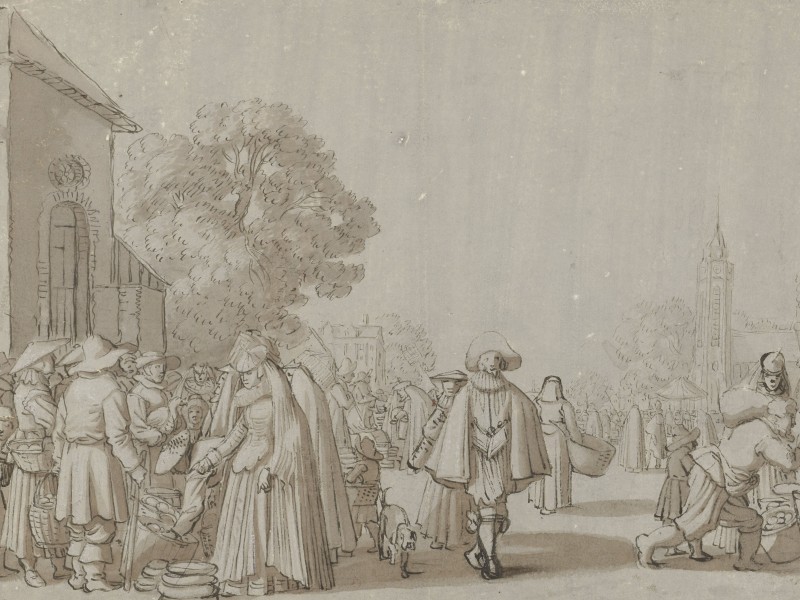
Unfortunately, our traveller did not explain how he understood the first part of the conversation. Perhaps he interpreted what he witnessed, or his two German companions, who spoke some Swedish, could translate what they understood for Kiechel.
Our traveller also learned that the Duke did not care much for etiquette and often spent half a day with an old peasant who told him about the customs of the country. This old peasant was allowed to enter the Duke’s residence and discuss events with him.
On 23 February, Kiechel left Strängnäs in a sledge with one of the merchants he had arrived with from Copenhagen. The horse and sledge belonged to a man from Stockholm who wanted to sell both items and had lent them to the travellers for a test ride. They travelled together in a convoy with five other sledges. Snow had fallen during the previous night, covering all tracks on the road. Most of the day, the convoy crossed a large frozen lake, and they arrived in Stockholm in the evening.
Illustrations & References
All images are in order of appearance with links to sources on external websites:
- Ortelius, Abraham, Theatre of the World, Antwerp 1587, fol. 90v; Library of Congress.
- ter Borch, Gerard, Vier studies van een paard en arrenslee, 1631; Rijksmuseum Amsterdam.
- van de Venne, Adriaen Pietersz, Man twee paarden vasthoudend en een man bij vogels, 1600 – 1662; Rijksmuseum Amsterdam.
- Anonymous, Östergötland, detaljkartor, 1653; Riksarkivet Stockholm.
- van de Velde, Esaias, Paardenmarkt, 1600 – 1630; Rijksmuseum Amsterdam.
- van de Velde, Jan, Marktscène, 1603 – 1641; Rijksmuseum Amsterdam.
- Die Reisen des Samuel Kiechel aus drei Handschriften, K. D. Haszler (ed.), Stuttgart 1866, p. 62; Bayerische Staatsbibliothek. ↩︎